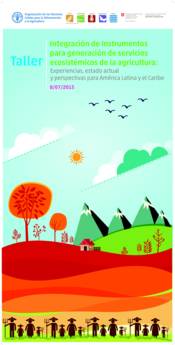Latin America Regional Policy Dialogue 2015

The First IES Regional Dialogue was held in Bogota, Colombia 7-8 July 2015. The event was organized in collaboration with FAO RLC and FAO Colombia, and coincided with discussions of the second draft of the Voluntary Guidelines for Agri-environmental Policies for Latin America and the Caribbean.
The workshop aimed to raise awareness on options to i) strengthen the coordination of agriculture and environmental sector institutions, ii) combine different incentives to support this integrated approach, and iii) create opportunities to increase and improve private sector engagement in sustainable agriculture.
Case studies illustrating the IES integrated approach were presented to share lessons learned and develop policy recommendations to improve cross-sectoral coordination.
Recommendations
Recommendation 1

Strengthening the coordination of institutions in the agricultural and environmental sectors to create space for the design and implementation of incentive systems; some examples were given during the meeting and other combinations are shown in Table 1 below:
- Colombia: The Ministry of Agriculture has a unit dedicated to harmonize rural agriculture and watershed management plans (Unidad de Planificación Rural Agropecuaria – UPRA http://www.upra.gov.co/ ). This unit advises the eligibility criteria of incentives schemes, such as rural loans, according to environmental sensitivity and productive potential of each area.
- Mexico: In areas of special biodiversity values within the Mesoamerican Biological Corridor (CBMM), the Biodiversity Commission (CONABIO) acts as an umbrella, combining investment programmes from the Secretariat of Agriculture (SAGARPA) to increase farm productivity, with conservation incentives from the Forestry Commission (CONAFOR). At local level, due to the ephemeral nature of local government teams (3 years), local authorities have created Municipal Tables, an addition governing body that is permanent, with broad representation of private and civil sector and funds to keep a technical advisory team.
- Brazil: The Rio Rural programme (and the State’s agriculture extension and research agencies) builds local communities' capacity to plan their own future and write up a multi-sectoral plan for their micro-watershed. This allows them to use this plan as a fundraising tool to various public and private programmes, combining investments to produce a more integral rural development result.
Table 1. Possible combinations of measures
Table 1. Possible combinations of measures
| • Clarifying Land tenure: indigenous and traditional territories | Associated with: | • Land tax system that rewards the arrangements for sustainable use and discourage harmful practices to the environment |
| • Land use planning considering economic, ecological and social goals | ||
| • Tax incentives for: o Rehabilitation of degraded areas o Soil protection and water resources o Marketing of agri - environmental products | ||
| • Eliminate tax incentives for practices that do not comply with the agri -environmental principles | And compensate with: | • Environmental Certification mechanisms |
| • Increase credit lines, conditional on adoption of the agro-environmental principles | ||
| • Intensify campaigns targeted to food education | ||
| • Increase the participation of agri - environmental products in government procurement | ||
| • Basic research on production systems and sustainable use | Combined with: | • Encourage the local market of agri - environmental products |
| • Improve Environmental licensing system, and its enforcement | • Promote the organization of agro-industries, and the economic organization of producers , through associations and cooperatives | |
| • Public programs of technical assistance | ||
| • Basic research on production systems and sustainable use |
Recommendation 2
Earmarking funds from ecosystem service users to invest in their protection is key, but this needs to be enforced and investment planned carefully:
- Colombia: While the requirement to allocate a percentage of municipal budget to the protection of city’s headwaters is positive, the fact that this is earmarked for land purchase encounters social opposition and also does not ensure appropriate protection nor management; yet since it is only 1%, its impact is very limited.
Recommendation 3

Exploring flexible options to recognize use rights to facilitate participation in agri-environmental programmes, without necessarily requiring formal land tenure: this remains a key blockage for farmer participation in some of these programm
- In Brazil this is not required, and the local extension agents can assist in the process of attesting use rights, to allow access to agri-environmental support schemes.
Recommendation 4
Improving the implementation of regulation to reduce environmental and social impacts of large agribusiness companies needs to be complemented by creating opportunities to increase and improve their investment in sustainable agriculture. This must be accompanied by raising awareness of the consumers so they can better drive the market away from unsustainable and unhealthy products.

